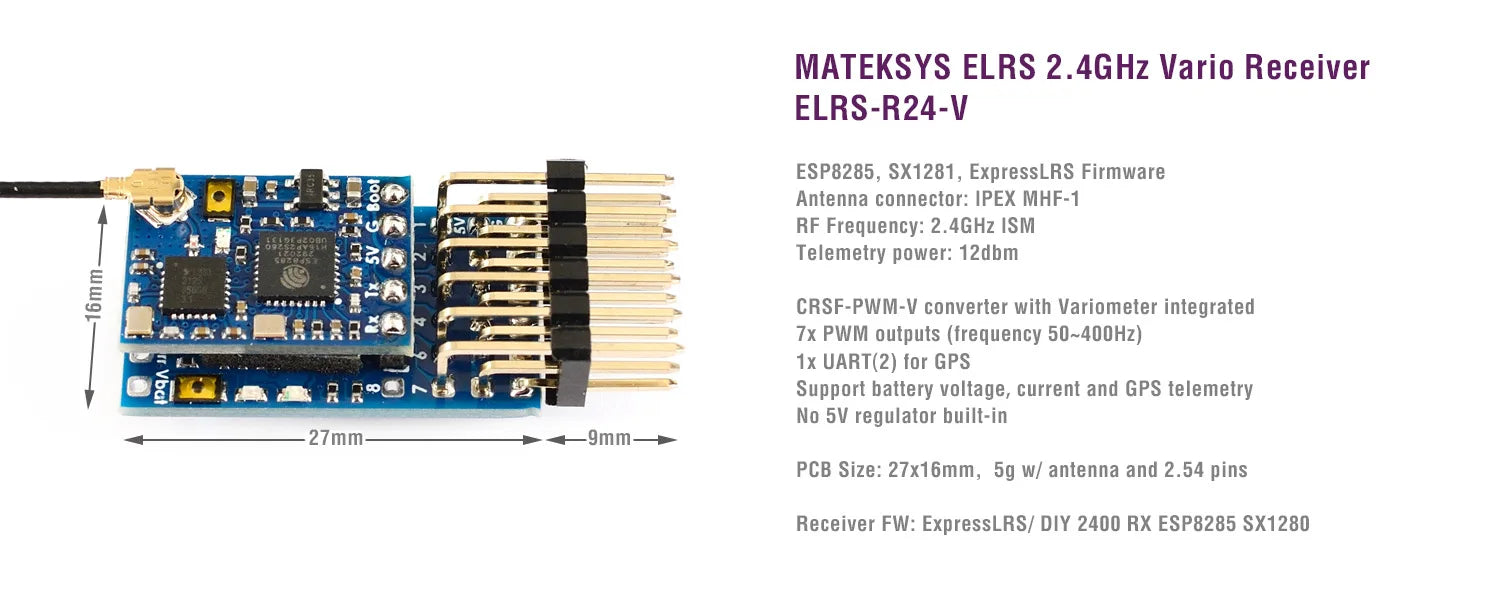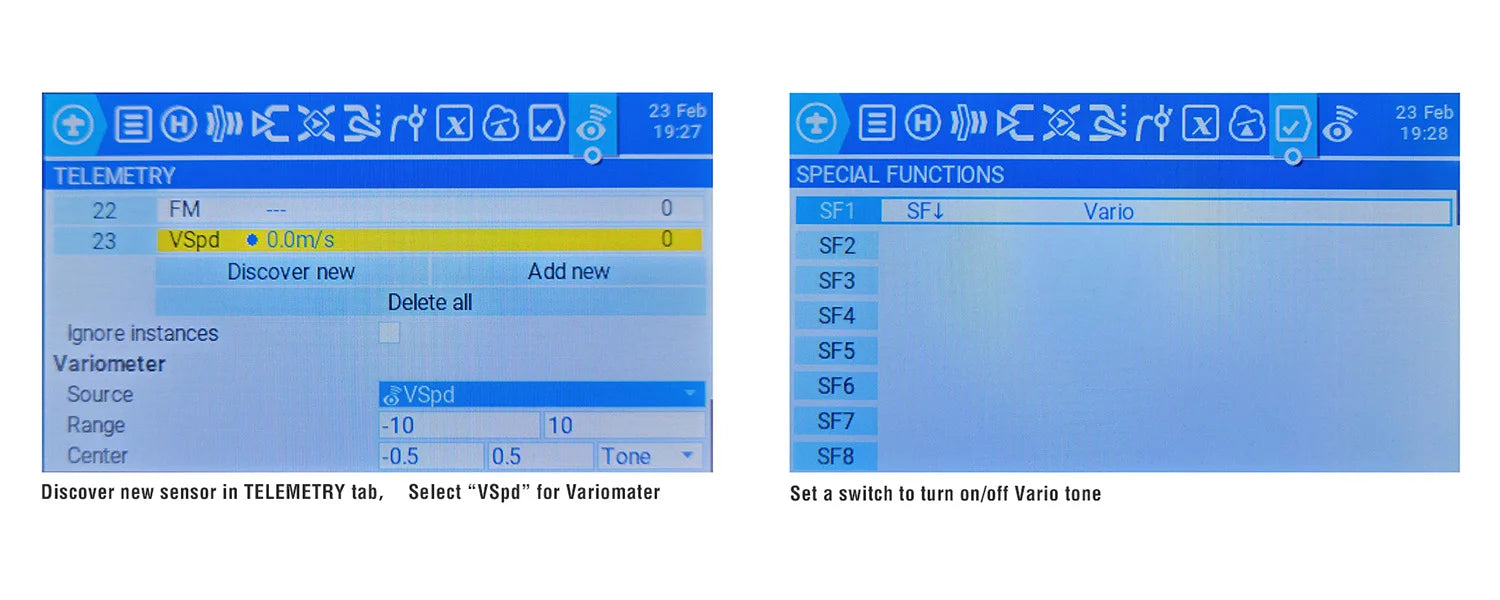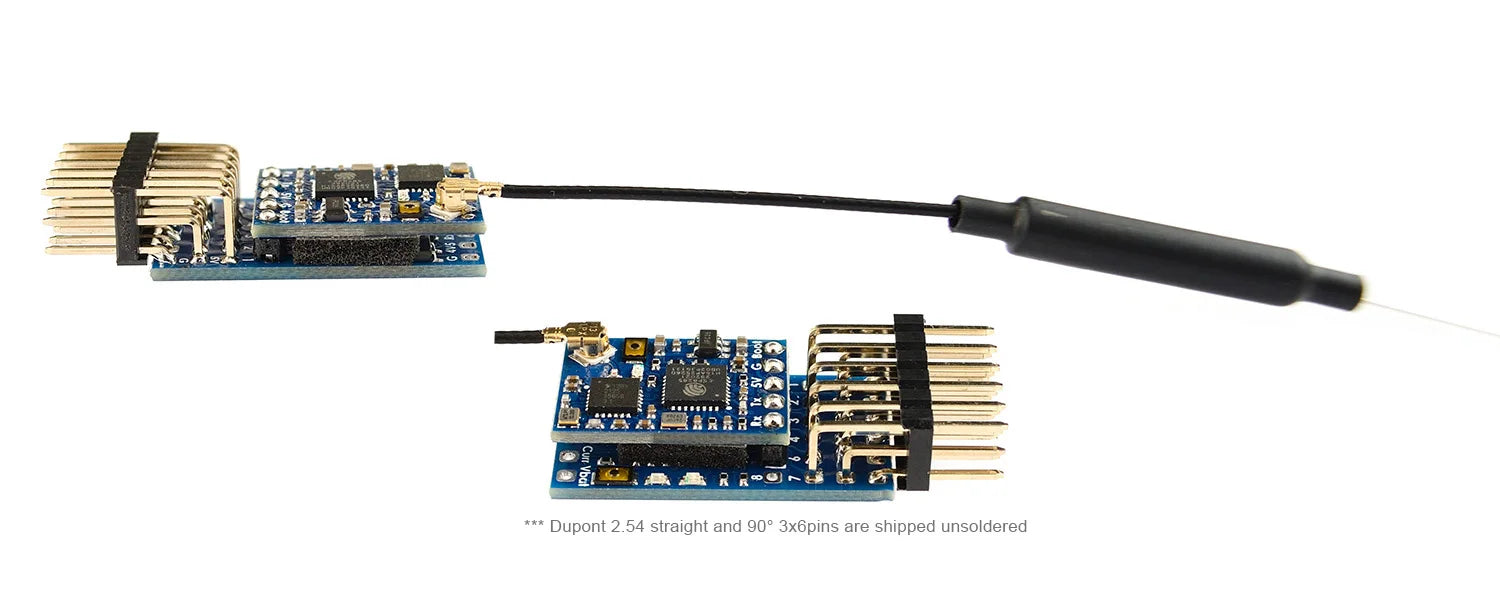MATEK Mateksys EXPRESSLRSELRS 2.4GHZ VARIO RECEIVER SPECIFICATIONS
Use: Vehicles & Remote Control Toys
Recommend Age: 12+y,14+y,3-6y,6-12y,0-3y
Origin: Mainland China
Material: Composite Material
Brand Name: MATEKSYS
EXPRESSLRS/ELRS 2.4GHZ VARIO RECEIVER
ExpressLRS firmware, 2.4GHz, 7x PWM outputs, Variometer sensor integrated.

BARO "ALT" READOUT
-
Start with EdgeTX 2.7.1/OpenTX 2.3.15 and ExpressLRS 2.5, Baro Alt telemetry ID is supported in CRSF protocol.
-
You need to update Transmitter, ExpressLRS TX module and Receiver all to latest verison.
-
and update CRSF-PWM-V to V2.3.0 or newer. http://www.mateksys.com/?portfolio=crsf-pwm#tab-id-6



-
Specific for the Gliders and other fixed-wings. Small in form factor, It can be installed in gliders with restricted payload bays such as DLG’s and high performance slopers. Not needing to install an additional altimeter/variometer also saves room and weight.
-
The built in barometer provides vertical speed telemetry. The variometer sounds both ascending and descending tones, so you will know whether you are in lift or sink without having to look at your transmitter.
-
with ExpressLRS firmware and CRSF protocol, this will also give you other telemetry data like battery voltage, current and GPS related.
Specifications
-
ESP8285, SX1281, ExpressLRS Firmware
-
RF Frequency: 2.4GHz ISM (2400~2480MHz)
-
Antenna connector: IPEX MHF-1
-
Telemetry power: 12dbm
-
CRSF-PWM-V converter with barometer integrated
-
7x PWM outputs (6x with power rails, PWM8 is just a signal pad)
-
PWM frequency: 50, 100, 160, 330, 400Hz configurable
-
PWM resolution: 4x 1024 position + 3x 128 position(ExpressLRS 2.0 Wide switch mode)
-
1x UART(2) for GPS
-
36V Max. battery voltage sense (1K:10K voltage divider built-in)
-
Compatible with external Current sensor (0~3.3V)
-
RxBt,Curr,Capa,Bat%,GPS telemetry and VSpd(Vario)
-
Rated voltage: 3.5~9V @5V pad, 0~36V @Vbat, 0~3.3V @Curr
-
Power dissipation: 50mA(binding), 90mA(wifi mode)
-
No 5V regulator built-in, Servos must be powered via 5V pad on CRSF-PWM-V board by external 5V source.
-
Failsafe value configurable
-
Firmware upgradeable
-
Physical:
-
PCB Size: 27x16mm,
-
Weight: 5g w/ antenna and 2.54 pins
-
-
Packing:
-
1x ELRS-R24-V(includes CRSF-PWM-V and 2.4G Receiver)
-
1x IPEX MHF1 Antenna
-
2.54mm straight and 90° 3×6 Dupont pins
-
Firmwares
-
2.4GHz Receiver: ExpressLRS /DIY_2400_RX_ESP8285_SX1280, V2.0 or newer
-
CRSF-PWM-V: crsf_pwm_v2.0 or newer
Pinouts and Pads
-
Tx1/Rx1(UART1) for Receiver integrated
-
Tx2/Rx2(UART2) for GPS/firmware update/setting parameters
-
1~8: CH1~CH8 PWM outputs
-
Curr: current sensor signal (0~3.3V)
-
Vbat: 0~36V Battery voltage sensing
-
G: ground
-
4v5 pad voltage = 5V pad voltage -0.3V.
-
no 5V regulator built-in, need to power on the board and receiver via external 5V source
Failsafe (FW 2.0.0 or newer)
-
CH3 is arranged for the throttle, Failsafe value = 988 by default. you can change the failsafe value of CH3 and other channels by following settings.
-
Make sure ESC signal is disconnected from CRSF-PWM board before starting failsafe settings
-
Bridge PWM1 and PWM2 signal pad, then power on CRSF-PWM board and receiver.
-
Failsafe value will be saved automatically after CRSF-PWM board is powered on and receive CRSF signal. LED blinks 8 times quickly.
-
Failsafe value = The PWM value of each transmitter channel when CRSF signal is received by CRSF-PWM board.
-
Remove the jumper between PWM 1 and 2, then CRSF-PWM board will work in normal PWM output mode.
LED status
-
slow blinks: CRSF-PWM board doesn’t receive CRSF signal, e.g., receiver is not bound with transmitter.
-
solid ON: CRSF-PWM board and receiver are working normally
-
5x fast blinks after powering on for 10 seconds: CLI mode is active
GPS telemetry
-
Compatible with GPS NMEA protocol, 1Hz, Baud 9600~115200
-
GPS “TX” to CRSF-PWM board “RX” Single wire half duplex UART connection, CRSF-PWM board “TX” to GPS “RX” is not essential.
-
Support GPS Telemetry ID: GPS, GSpd, Hdg, Alt, Sats
-
u-blox series GPS can output “0+1 – UBX+NMEA” protocol by default
-
Sensors(GPS, GSpd, Hdg, Alt, Sats) will blink in Transmitter TELEMETRY tab once CRSF-PWM board has connection with GPS.
-
Troubleshooting for no GPS telemetry, double check the wiring between GPS and CRSF-PWM board, some u-blox GPS may don’t output NMEA protcol, you need to revert GPS to default configuration in u-center.
-
with OpenTX Telemetry Logging, You can plot your flight path or search the lost plane.
VSpd telemetry
-
Barometer SPL06-001 (I2C address 0x76) integrated
-
VSpd telemetry is supported by ExpressLRS 2.0, EDGE 2.6, OPENTX 2.2 or newer.
TIM & PWM Frequency
-
PWM frequency on all 10x Channels can be configured according to TIM
-
PWM run at 50Hz by default
-
TIM2: CH1, CH2, CH4
-
TIM16: CH3
-
TIM3: CH5, CH6, CH7, CH8
CLI mode
-
If CRSF-PWM board doesn’t detect GPS connected to UART2 within 10 seconds after powering on, CLI mode will active.
-
After CLI mode is active, CRSF-PWM board can be connected to configurator via USB-TTL module/FC passthrough.
-
in CLI mode, CRSF-PWM board firmware can be updated
-
CLI mode has no effect to receiver CRSF signal and PWM outputs
Firmwares
-
Pls view CRSF TO PWM CONVERTER page for firmware update of CRSF-PWM-V board
-
Tool: Matek Configurator
-
via A or B
FOR MORE
Related Collections



Explore More Drones & Accessories
-

Camera Drone
Our Camera Drone Collection features a wide range of brands including FIMI,...
-

Drone Accessories
Discover a wide range of drone accessories to enhance flight performance, extend...






